Abstract
1. The production of 14CO2 from S-adenosyl[carboxyl-14C]methionine by rat liver extracts was investigated. It was found that, in addition to the well-known cytosolic putrescine-activated S-adenosylmethionine decarboxylase, an activity carrying out the production of 14CO2 could be extracted from a latent, particulate or membrane-bound form by treatment with buffer containing 1% (v/v) Triton X-100 [confirming the report of Sturman (1976) Biochim. Biophys. Acta 428, 56–69]. 2. The formation of 14CO2 by such detergent-solubilized extracts differed from that by cytosolic S-adenosylmethionine decarboxylase in a number of ways. The reaction by the solubilized extracts did not require putrescine and was not directly proportional to time of incubation or the amount of protein added. Instead, activity a showed a distinct lag period and was much greater when high concentrations of the extracts were used. The cytosolic S-adenosylmethionine decarboxylase was activated by putrescine, showed strict proportionality to protein added and the reaction proceeded at a constant rate. Cytosolic activity was not inhibited by homoserine or by S-adenosylhomocysteine, whereas the Triton-solubilized activity was strongly inhibited. 3. By using an acetone precipitate of Triton-treated homogenates as a source of the activity, it was found that decarboxylated S-adenosylmethionine was not present among the products of the reaction, although 5′-methylthioadenosine and 5-methylthioribose were found. Such extracts were able to produce 14CO2 when incubated with [U-14C]-homoserine, and 14CO2 production was greater when S-adenosyl[carboxyl-14C]methionine that had been degraded by heating at pH6 at 100°C for 30min (a procedure known to produce mainly 5′-methylthioadenosine and homoserine lactone) was used as a substrate than when S-adenosyl[carboxyl-14C]methionine was used. 4. These results indicate that the Triton-solubilized activity is not a real S-adenosylmethionine decarboxylase, but that 14CO2 is produced via a series of reactions involving degradation of the S-adenosyl-[carboxyl-14C]methionine. It is probable that this degradation can occur via several pathways. Our results would suggest that part of the reaction occurs via the production of S-adenosylhomocysteine, which can then be converted into 2-oxobutyrate via the transsulphuration pathway, and that part occurs via the production of homoserine by an enzyme converting S-adenosylmethionine into 5′-methylthioadenosine and homoserine lactone.
Full text
PDF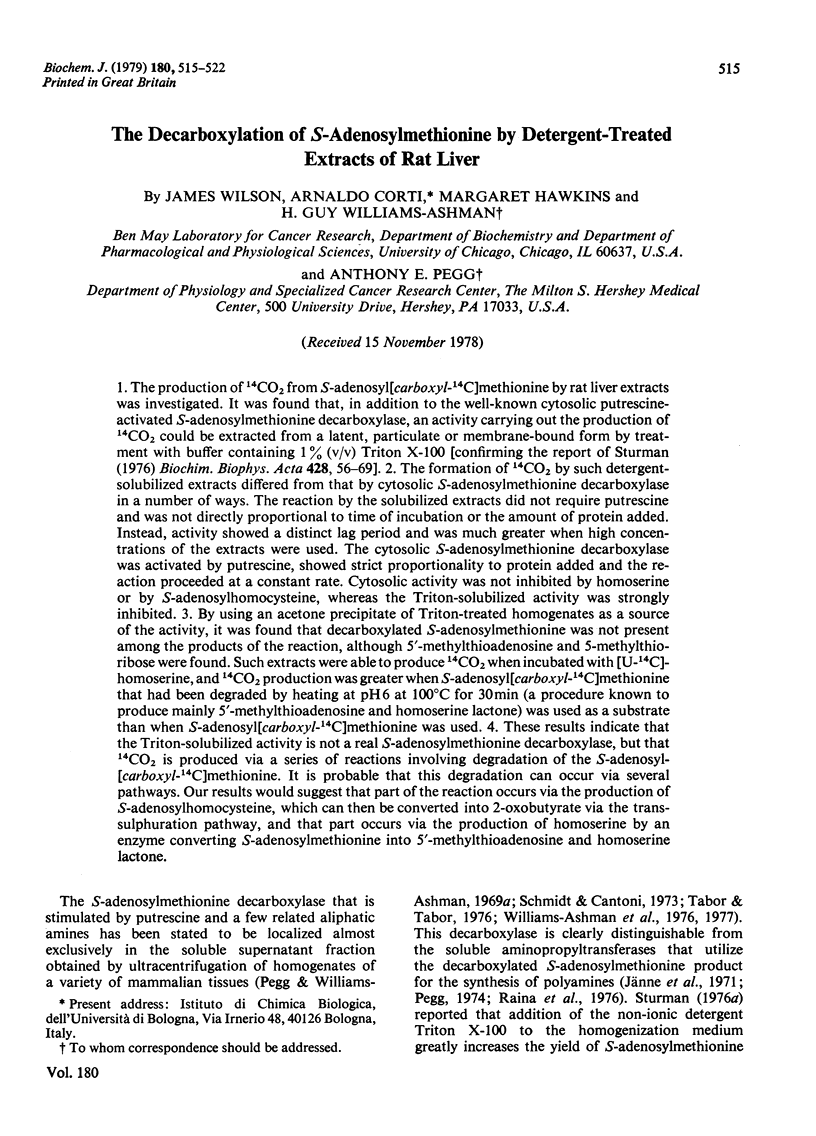
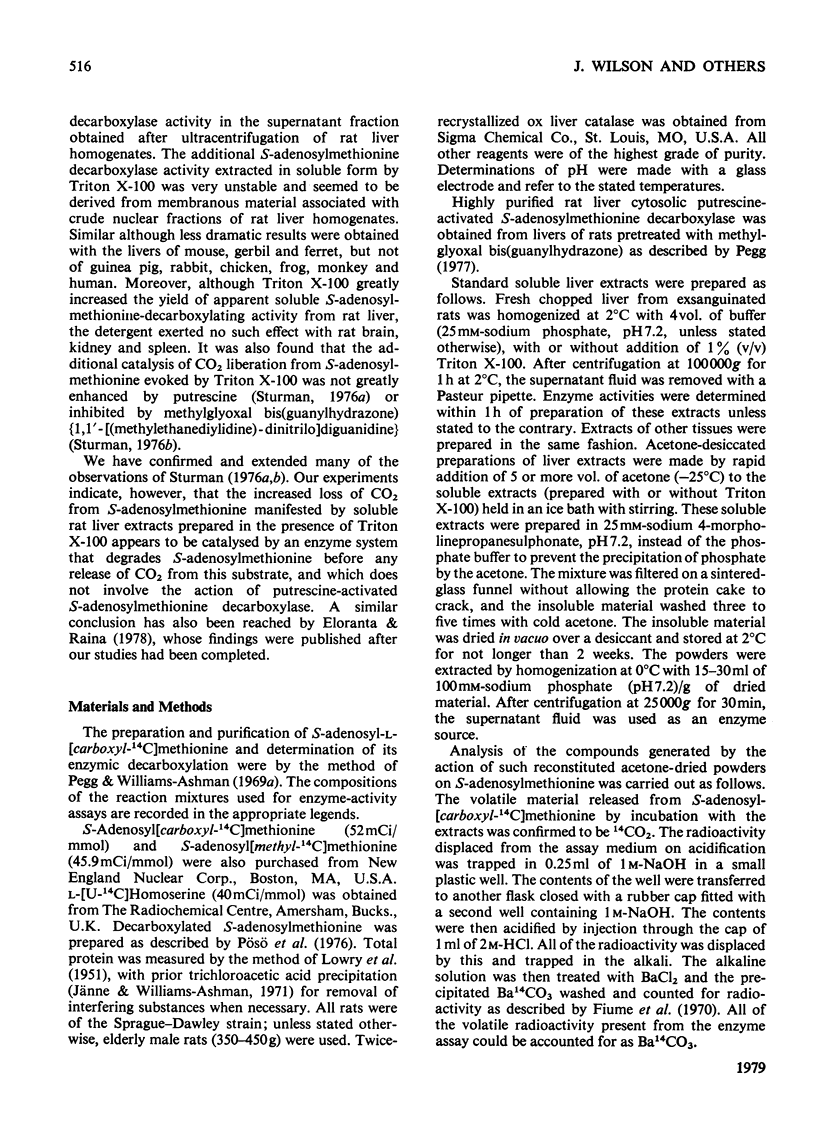
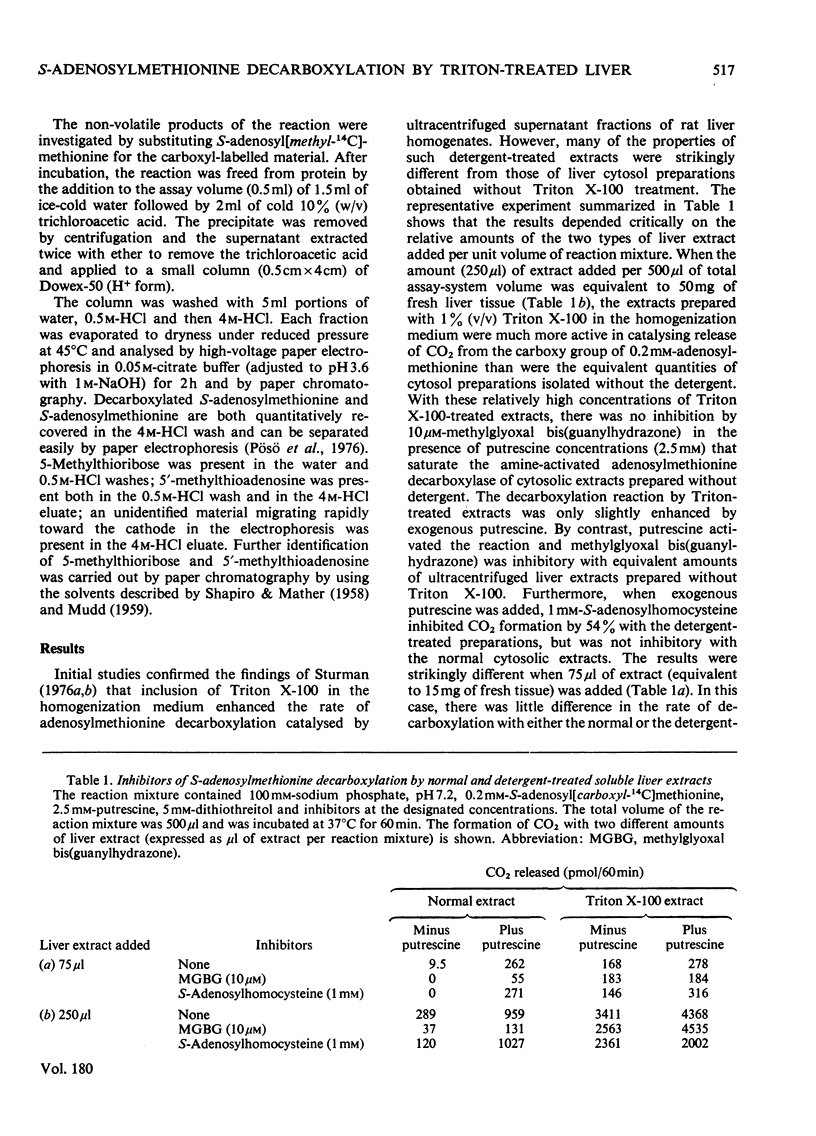
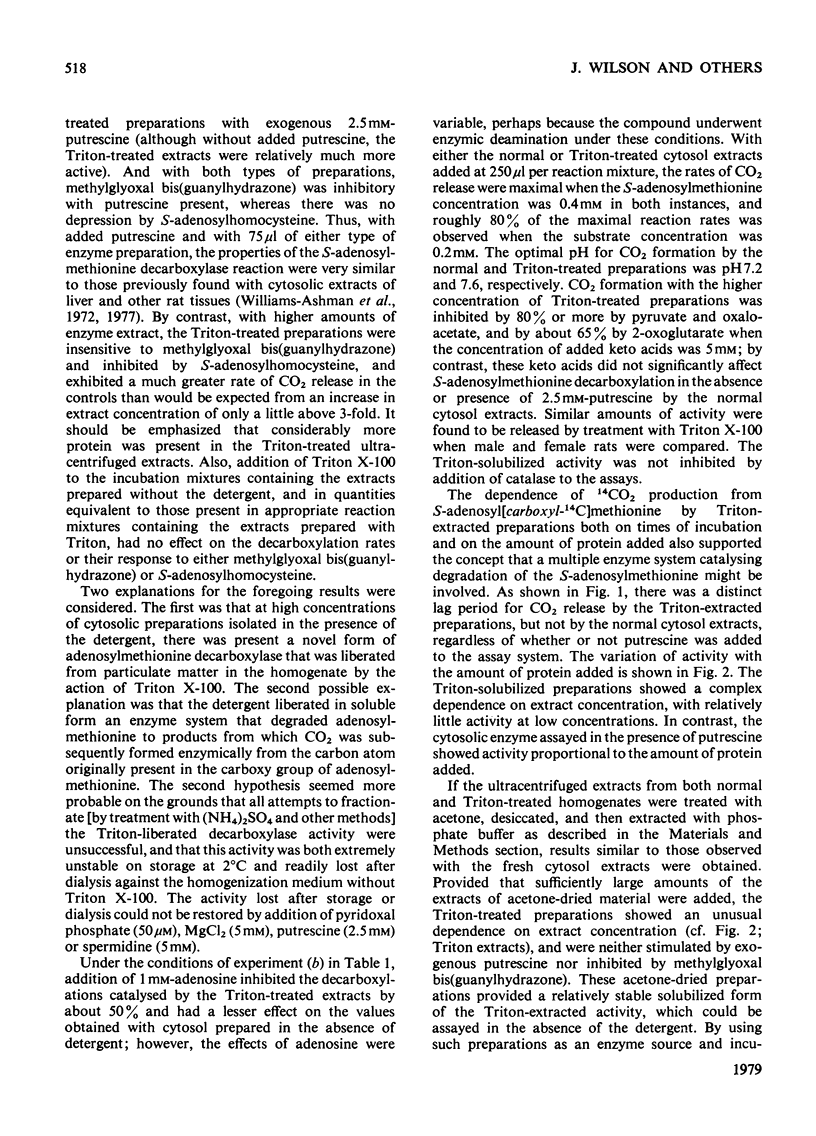
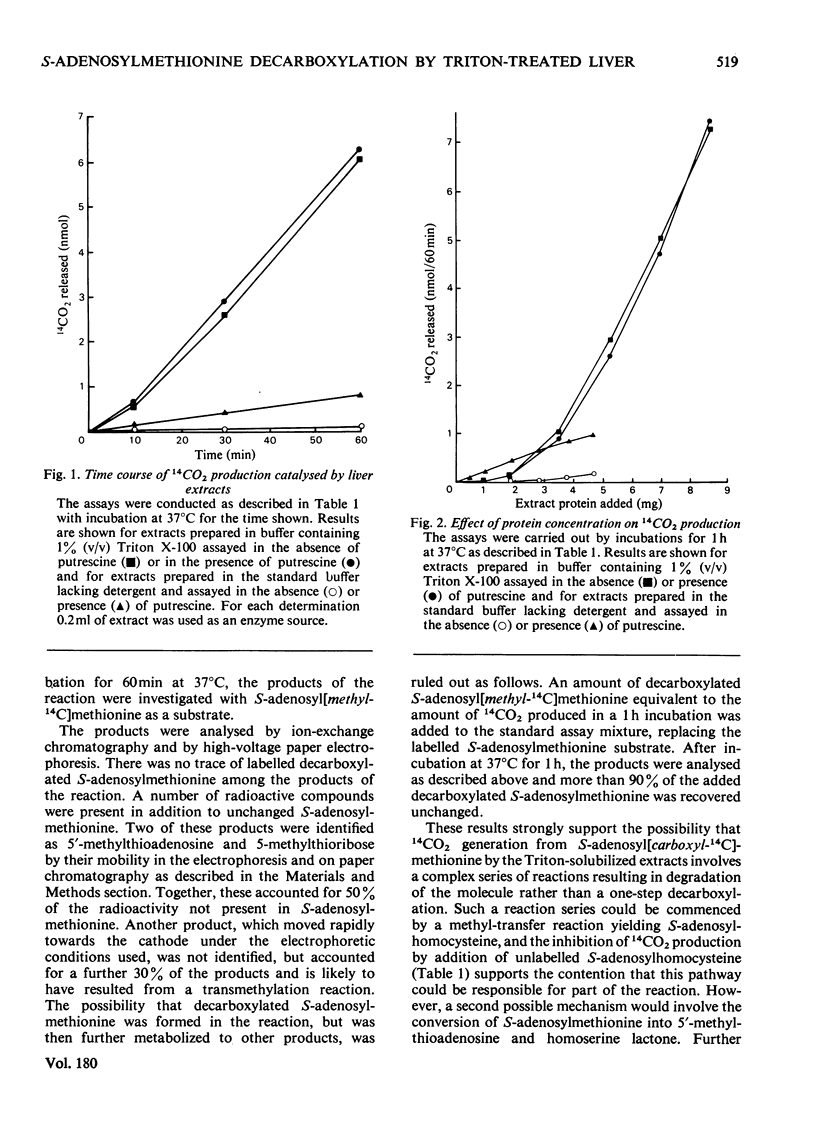
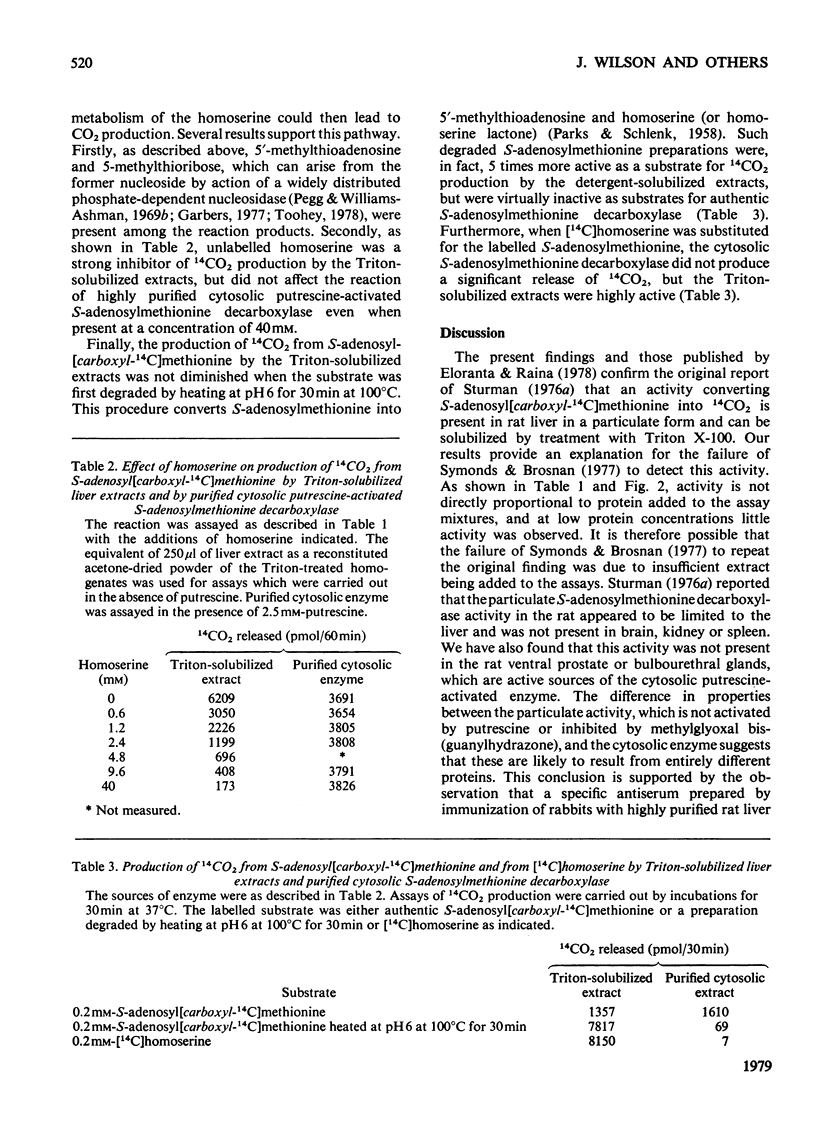
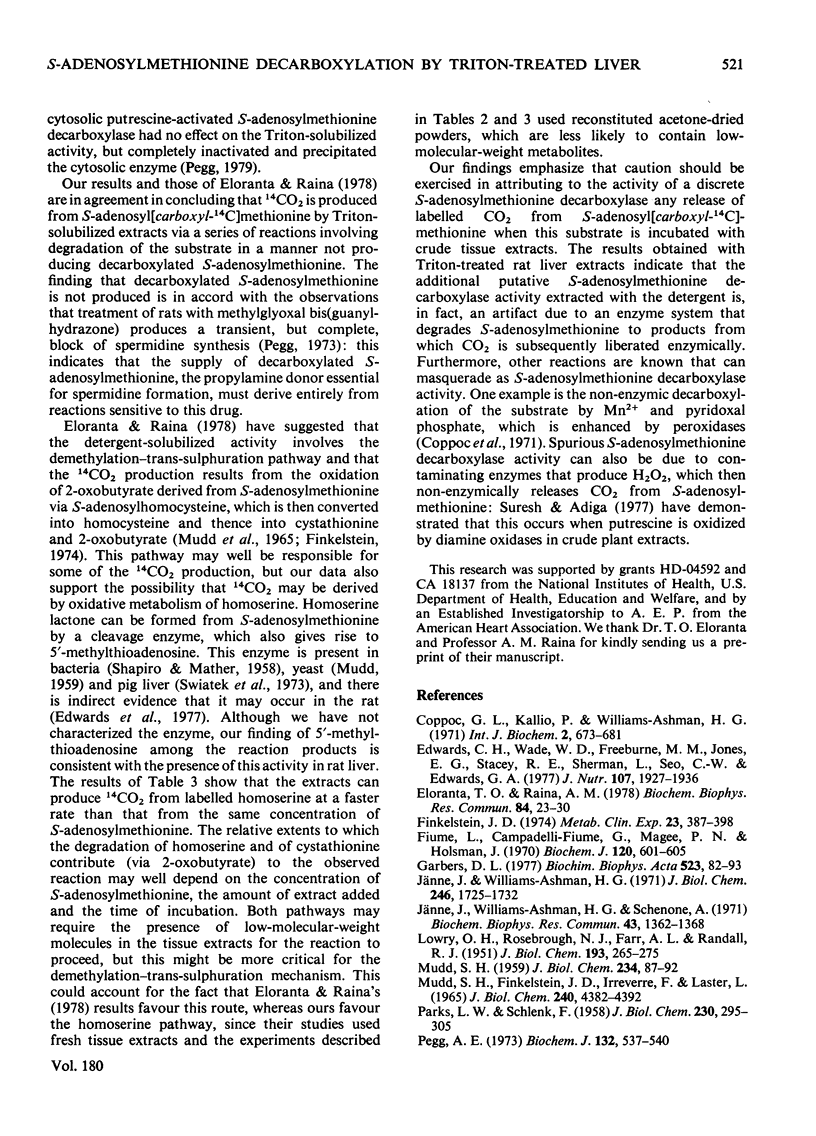
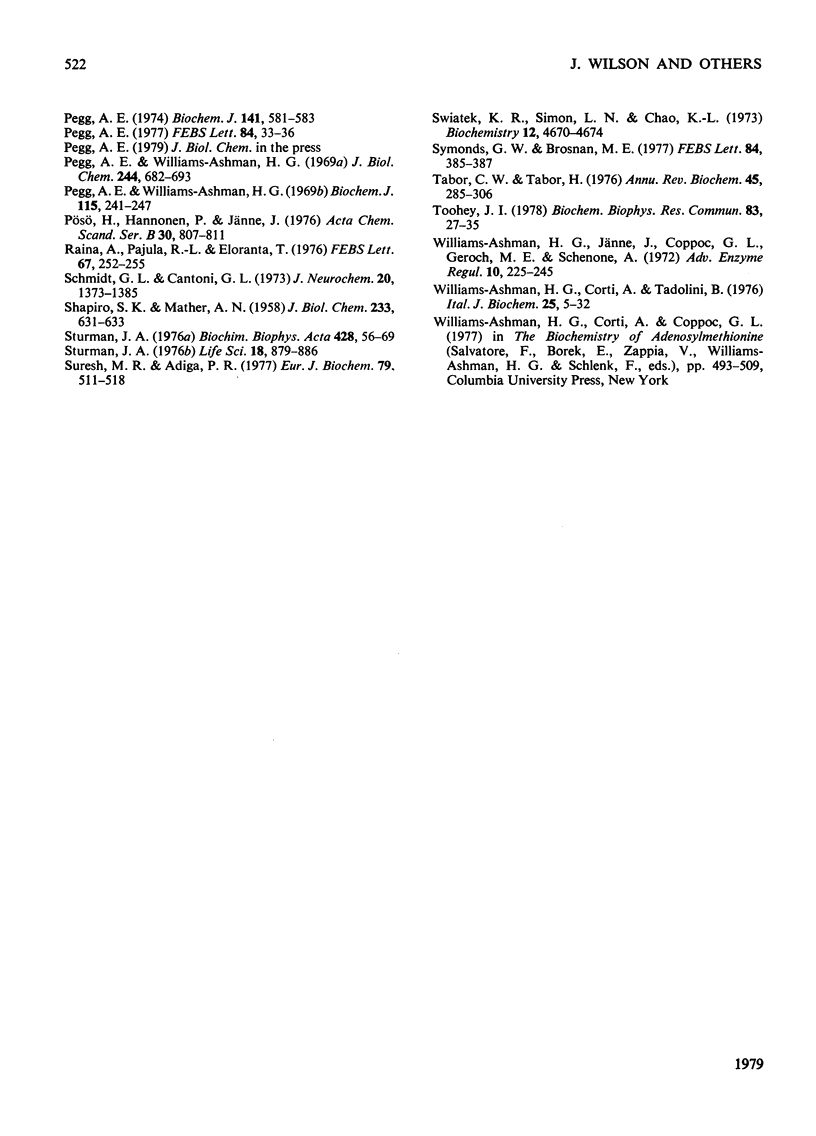
Selected References
These references are in PubMed. This may not be the complete list of references from this article.
- Edwards C. H., Wade W. D., Freeburne M. M., Jones E. G., Stacey R. E., Sherman L., Seo C. W., Edwards G. A. Formation of methionine from alpha-amino-n-butyric acid and 5'-methylthioadenosine in the rat. J Nutr. 1977 Oct;107(10):1927–1936. doi: 10.1093/jn/107.10.1927. [DOI] [PubMed] [Google Scholar]
- Eloranta T. O., Raina A. M. Formation of CO2 from the carboxyl group of S-adenosylmethionine by liver membrane-associated enzymes involves the demethylation-transsulphuration pathway. Biochem Biophys Res Commun. 1978 Sep 14;84(1):23–30. doi: 10.1016/0006-291x(78)90257-7. [DOI] [PubMed] [Google Scholar]
- Finkelstein J. D. Methionine metabolism in mammals: the biochemical basis for homocystinuria. Metabolism. 1974 Apr;23(4):387–398. doi: 10.1016/0026-0495(74)90057-2. [DOI] [PubMed] [Google Scholar]
- Fiume L., Campadelli-Fiume G., Magee P. N., Holsman J. Cellular injury and carcinogenesis. Inhibition of metabolism of dimethylnitrosamine by aminoacetonitrile. Biochem J. 1970 Dec;120(3):601–605. doi: 10.1042/bj1200601. [DOI] [PMC free article] [PubMed] [Google Scholar]
- Garbers D. L. Demonstration of 5'-methylthioadenosine phosphorylase activity in various rat tissues. Some properties of the enzyme from rat lung. Biochim Biophys Acta. 1978 Mar 14;523(1):82–93. doi: 10.1016/0005-2744(78)90011-6. [DOI] [PubMed] [Google Scholar]
- Janne J., Williams-Ashman H. G., Schenone A. Spermidine synthesizing enzymes in baker's yeast. Biochem Biophys Res Commun. 1971 Jun 18;43(6):1362–1368. doi: 10.1016/s0006-291x(71)80024-4. [DOI] [PubMed] [Google Scholar]
- Jänne J., Williams-Ashman H. G. On the purification of L-ornithine decarboxylase from rat prostate and effects of thiol compounds on the enzyme. J Biol Chem. 1971 Mar 25;246(6):1725–1732. [PubMed] [Google Scholar]
- MUDD S. H. Enzymatic cleavage of S-adenosylmethionine. J Biol Chem. 1959 Jan;234(1):87–92. [PubMed] [Google Scholar]
- Mudd S. H., Finkelstein J. D., Irreverre F., Laster L. Transsulfuration in mammals. Microassays and tissue distributions of three enzymes of the pathway. J Biol Chem. 1965 Nov;240(11):4382–4392. [PubMed] [Google Scholar]
- PARKS L. W., SCHLENK F. The stability and hydrolysis of S-adenosylmethionine; isolation of S-ribosylmethionine. J Biol Chem. 1958 Jan;230(1):295–305. [PubMed] [Google Scholar]
- Pegg A. E. Evidence for the presence of pyruvate in rat liver S-adenosylmethionine decarboxylase. FEBS Lett. 1977 Dec 1;84(1):33–36. doi: 10.1016/0014-5793(77)81051-x. [DOI] [PubMed] [Google Scholar]
- Pegg A. E. Inhibition of spermidine formation in rat liver and kidney by methylglyoxal bis(guanylhydrazone). Biochem J. 1973 Mar;132(3):537–540. doi: 10.1042/bj1320537. [DOI] [PMC free article] [PubMed] [Google Scholar]
- Pegg A. E. Purification of rat liver S-adenosyl-L-methionine decarboxylase. Biochem J. 1974 Aug;141(2):581–583. doi: 10.1042/bj1410581. [DOI] [PMC free article] [PubMed] [Google Scholar]
- Pegg A. E., Williams-Ashman H. G. On the role of S-adenosyl-L-methionine in the biosynthesis of spermidine by rat prostate. J Biol Chem. 1969 Feb 25;244(4):682–693. [PubMed] [Google Scholar]
- Pegg A. E., Williams-Ashman H. G. Phosphate-stimulated breakdown of 5'-methylthioadenosine by rat ventral prostate. Biochem J. 1969 Nov;115(2):241–247. doi: 10.1042/bj1150241. [DOI] [PMC free article] [PubMed] [Google Scholar]
- Raina A., Pajula R. L., Eloranta T. A rapid assay method for spermidine and spermine synthases. Distribution of polyamine-synthesizing enzymes and methionine adenosyltransferase in rat tissues. FEBS Lett. 1976 Sep 1;67(3):252–255. doi: 10.1016/0014-5793(76)80540-6. [DOI] [PubMed] [Google Scholar]
- SHAPIRO S. K., MATHER A. N. The enzymatic decomposition of S-adenosyl-L-methionine. J Biol Chem. 1958 Sep;233(3):631–633. [PubMed] [Google Scholar]
- Schmidt G. L., Cantoni G. L. Adenosylmethionine decarboxylase in developing rat brain. J Neurochem. 1973 May;20(5):1373–1385. doi: 10.1111/j.1471-4159.1973.tb00249.x. [DOI] [PubMed] [Google Scholar]
- Sturman J. A. Effect of methylglyoxal bis (guanylhydrazone) (MGBG) in vivo on the decarboxylation of s-adenosylmethionine and synthesis of spermidine in the rat and guinea pig. Life Sci. 1976 Apr 15;18(8):879–886. doi: 10.1016/0024-3205(76)90015-1. [DOI] [PubMed] [Google Scholar]
- Sturman J. A. Subcellular distribution of S-adenosylmethionine decarboxylase in rat liver. Evidence of decarboxylation of S-adenosylmethionine separate from synthesis of spermidine. Biochim Biophys Acta. 1976 Mar 25;428(1):56–69. doi: 10.1016/0304-4165(76)90108-2. [DOI] [PubMed] [Google Scholar]
- Suresh M. R., Adiga P. R. Putrescine-sensitive (artifactual) and insensitive (biosynthetic) S-adenosyl-L-methionine decarboxylase activities of Lathyrus sativus seedlings. Eur J Biochem. 1977 Oct 3;79(2):511–518. doi: 10.1111/j.1432-1033.1977.tb11835.x. [DOI] [PubMed] [Google Scholar]
- Swiatek K. R., Simon L. N., Chao K. L. Nicotinamide methyltransferase and S-adenosylmethionine: 5'-methylthioadenosine hydrolase. Control of transfer ribonucleic acid methylation. Biochemistry. 1973 Nov 6;12(23):4670–4674. doi: 10.1021/bi00747a019. [DOI] [PubMed] [Google Scholar]
- Symonds G. W., Brosnan M. E. Subcellular localization of putrescine-dependent S-adenosyl methionine decarboxylase in rat liver. FEBS Lett. 1977 Dec 15;84(2):385–387. doi: 10.1016/0014-5793(77)80730-8. [DOI] [PubMed] [Google Scholar]
- Tabor C. W., Tabor H. 1,4-Diaminobutane (putrescine), spermidine, and spermine. Annu Rev Biochem. 1976;45:285–306. doi: 10.1146/annurev.bi.45.070176.001441. [DOI] [PubMed] [Google Scholar]
- Toohey J. I. Methylthioadenosine nucleoside phosphorylase deficiency in methylthio-dependent cancer cells. Biochem Biophys Res Commun. 1978 Jul 14;83(1):27–35. doi: 10.1016/0006-291x(78)90393-5. [DOI] [PubMed] [Google Scholar]
- Williams-Ashman H. G., Corti A., Tadolini B. On the development of specific inhibitors of animal polyamine biosynthetic enzymes. Ital J Biochem. 1976 Jan-Feb;25(1):5–32. [PubMed] [Google Scholar]
- Williams-Ashman H. G., Jänne J., Coppoc G. L., Geroch M. E., Schenone A. New aspects of polyamine biosynthesis in eukaryotic organisms. Adv Enzyme Regul. 1972;10:225–245. doi: 10.1016/0065-2571(72)90016-7. [DOI] [PubMed] [Google Scholar]


